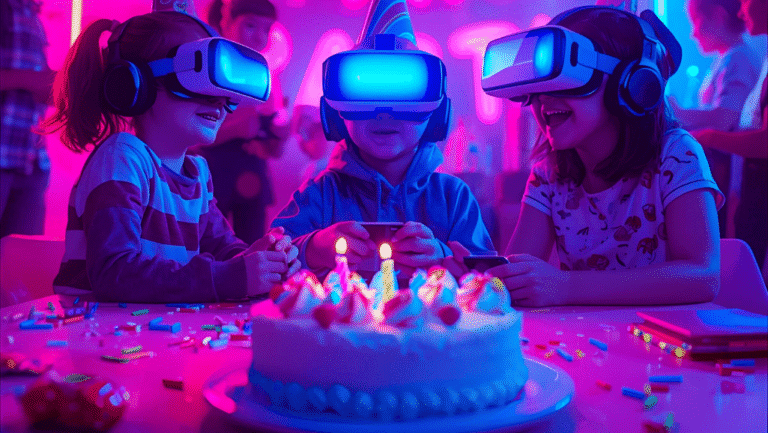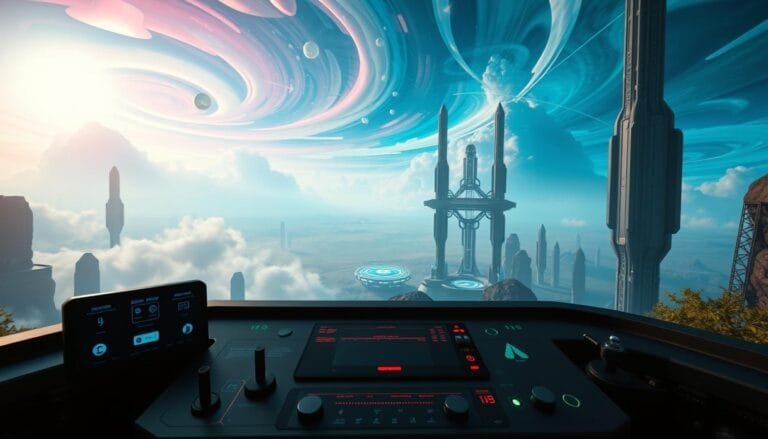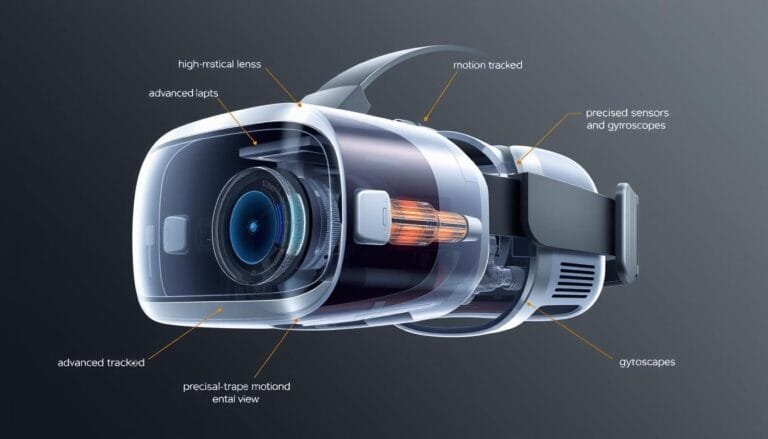The rise of virtual reality technology has opened a new era. Now, digital reality platforms take us into worlds once only dreamed of. The virtual reality world is changing how we learn and experience things.
These immersive virtual reality worlds are more than just fun. They teach us real skills from many careers, all safely from home. You can practice being a firefighter, a pilot, or a chef without any danger.
Thanks to immersive experiences and advanced VR headsets, the line between real and imagined is getting blurry. This lets us explore and interact in ways we never thought possible.
Key Takeaways
- Virtual reality world platforms are breaking boundaries in providing safe, yet genuine, professional simulations.
- Advent of immersive 3D virtual reality experience opens up new vistas for learning and skill development.
- Versatility of virtual reality technology extends beyond entertainment to educational and professional training domains.
- Virtual environments foster a deep sense of presence and interactivity, making experiences feel real.
- Digital reality platforms continue to revolutionize the way we perceive and interact with information.
- Accessibility of immersive experiences via VR headsets is democratisizing the realm of virtual exploration.
The Genesis and Evolution of Virtual Reality Technology
Virtual reality started as a dream in science fiction. Now, it’s a key part of our technology world, changing many industries. It began with early ideas and inventions that seemed impossible back then. These ideas helped create the interactive 3D worlds and immersive virtual worlds we love today.
The Early Days of VR: From Science Fiction to First Prototypes
Charles Wheatstone started it all in 1838 with stereoscopic photos and viewers. This was the first step towards seeing things in depth. By 1929, Edward Link’s flight simulator, the Link Trainer, made flying feel real for pilots. This was a big step in making VR feel real.
Stanley G. Weinbaum’s stories in the 1930s also played a big role. He imagined VR goggles that could touch and see. His ideas were ahead of their time.
The Rise of Commercial VR Platforms and Headsets
VR started to grow in 2014 when Facebook bought Oculus VR for $2 billion. This showed everyone how serious VR was. Since then, VR technology and headsets have gotten better and cheaper. This made VR more available to everyone.
The Oculus Quest 2 in 2020 was a big step forward. It offered great VR without needing a computer. This made VR even more appealing to more people.
Advancements in Immersive Experiences and Interactive 3D Worlds
As VR got better, so did the worlds it created. Mixing VR with augmented reality made these worlds even more real. The Meta Quest 3 is a great example of this. It’s easy to use and affordable, making VR more fun for everyone.
| Year | Innovation | Contributor |
|---|---|---|
| 1838 | Stereoscopic photos and viewers | Charles Wheatstone |
| 1929 | First flight simulator (Link Trainer) | Edward Link |
| 1968 | First VR/AR head-mounted display | Ivan Sutherland and Bob Sproull |
| 1975 | First interactive VR system (VIDEOPLACE) | Myron Krueger |
| 2020 | Launch of Oculus Quest 2 | Meta (formerly Facebook) |
How Virtual Reality Headsets Are Redefining Entertainment
Virtual reality headsets have changed the world of entertainment. They offer immersive virtual reality experiences that grab our attention. From exciting virtual reality gaming to interactive social platforms and learning tools, VR’s impact is wide. It’s changing how we enjoy digital content.
Since the mid-2010s, virtual reality headset models like Oculus Quest and HTC Vive have made VR more common. This has opened up VR experiences to more people. It’s helped make VR game experiences better, making games more emotional and helping people connect through virtual worlds.
Virtual reality gaming lets players dive into amazing worlds. It also improves skills like spatial awareness and navigation. Plus, VR gaming is great for the brain, helping it adapt and stay sharp.
| Area of Impact | Examples | Benefits |
|---|---|---|
| Entertainment and Gaming | VR headsets like Oculus, HTC Vive | Enhanced emotional engagement, increased realism |
| Social Interaction | Platforms like VRChat | Opportunities for socialization in virtual spaces |
| Education | Immersive learning applications | Interactive and engaging learning environments |
| Healthcare | Virtual training for surgeons | Improved precision and skill in operations |
| Virtual Events | Live VR concerts and performances | Attend events from anywhere in the world |
The rise in VR experiences, especially in virtual reality gaming, shows a trend. People want tech that entertains, educates, and connects. As VR gets better, it will likely enter more areas, changing how we interact with digital stuff.
Virtual Reality World: Merging Digital and Physical Realms
The world of technology is changing fast. Now, we mix virtual reality with our real world. This mix makes digital simulations better and changes how we see and interact with both worlds.
Understanding the VR Environment and User Interactivity
In virtual reality, how we connect with digital things is key. An interactive virtual world lets us move around in a 3D space like we’re really there. This is useful not just for games but also for learning and training, where we can try things safely.
The Technology Behind Creating a 3D Virtual Space
Making these digital worlds is complex. It uses advanced graphics and special hardware for a smooth experience. These environments are designed to feel real, with all our senses involved.
Creating these worlds needs strong VR systems. They must map the environment and track our movements. This makes a space where we can fully dive into a virtual world.
| Technology | 2023 Projected Revenue (USD Billion) | Primary Uses |
|---|---|---|
| Virtual Reality (VR) | 32.1 | Gaming, Training, Simulations |
| Augmented Reality (AR) | N/A | Retail, Advertising, Education |
| Mixed Reality (MR) | N/A | Education, Design, Healthcare |
AR and VR together are growing the market and changing many fields. They offer new ways to interact and experience things. As we keep exploring these virtual worlds, the possibilities are endless.
Virtual Reality Gaming: The New Frontier of Digital Play
As virtual reality technology evolves, it’s changing the gaming world a lot. Virtual reality gaming makes digital play richer and helps build big, active vr gaming communities. More people are trying VR gaming, with a 30% increase in the last year.
VR gaming lets players connect in new ways. It’s all about socializing, with a 40% jump in user engagement in social VR platforms. These platforms host events that bring the vr gaming community together, creating a space for both fun and socializing.
VR gaming is also changing other areas, like the economy and education. The virtual economy is expected to grow to $20 billion by 2025. This shows how VR gaming can open up new business and learning opportunities.
| Area of Impact | Growth Rate / Improvement |
|---|---|
| VR Gaming Adoption | 30% increase |
| VR in Education | 25% increase in engagement |
| Medical Training Efficiency | 15% increase |
| VR in A&E Project Completion | 30% faster |
| Accessibility to VR Technologies | 12% have affordable access |
VR technology is getting better and more people can use it. It’s changing gaming, education, and even work training. As VR gaming grows, it shows us a future where the virtual and real worlds blend together.
Immersive Educational Experiences Through Virtual Reality
Education is changing with virtual reality applications. This new way of learning is making learning more fun and effective. Immersive educational experiences with VR are changing how we learn in many areas.
Virtual reality simulations are leading this change. They use virtual worlds that look like real places. This lets learners dive deep into complex topics.
VR uses 360-degree videos and CGI to make learning feel real. It’s important for learning to feel real and emotional.
- Engagement and Retention: VR makes learning feel like real life. This helps learners remember more.
- Accessibility: VR helps everyone learn. It adapts to different needs and learning styles.
- Collaborative Learning: VR creates spaces for teamwork. This helps learners work together, even from far away.
But, there are challenges with VR in education. Things like the cost of VR gear and the risk of getting sick from it. VR is great for learning by doing, but it needs careful use.
Overall, virtual reality applications are making learning better. They make it more fun, interactive, and open to everyone. As tech gets better, VR will offer even more ways to learn.
VR Simulation: A Tool for Professional Training and Development
Virtual Reality Simulation is changing how we train professionals. It turns old methods into new, interactive ways to learn. This mix of virtual reality and real-world use makes learning fun and engaging for many fields.
Many industries, like healthcare and engineering, use VR to improve training. In healthcare, VR helps doctors practice surgeries safely. This makes them better and faster at real surgeries.
In engineering, VR lets people practice with machines safely. This helps them understand how to use and maintain equipment better.
VR also saves money. It cuts down on travel costs and the need for physical training spaces. This makes top-notch training available to more places around the world.
VR also makes learning more exciting. People feel more connected to what they’re learning. This is especially true for jobs that are risky, like police and military work.
| Industry | Benefits of VR Training | Specific Applications |
|---|---|---|
| Healthcare | Enhanced skill development, risk reduction in surgeries | Virtual surgeries, procedural training |
| Engineering | Risk-free equipment handling, maintenance training | Operational simulations, safety protocols |
| Public Service | Real-world scenario preparation, decision-making skills | Marksmanship, tactical training, crisis management |
Virtual reality development also offers real-time feedback. This helps make training better and more effective. It lets trainers see how well people are learning and adjust the training as needed.
In short, VR simulation is changing professional training for the better. It makes learning more immersive, affordable, and effective. As technology keeps improving, VR will play an even bigger role in how we learn.
Architecting VR Worlds: The Craft Behind 3D Visualization and Design
VR world design is changing many industries. It brings immersive digital experiences to life. Creators use Unity and Unreal to make detailed, realistic environments. These environments are not just for games but also for architecture and real estate.
3D visualization is key for creating virtual reality landscapes. These landscapes are convincing and interactive. Over 60% of game developers use these platforms to create dynamic virtual environments.
The Role of VR in Building Virtual Environments
Virtual reality changes how we see architectural projects and real estate. No longer just flat blueprints, these projects come alive in virtual tours and models. This makes clients more engaged and satisfied before construction starts.
Collaborating Across Industries for Realistic World Design
Creating an augmented reality world needs teamwork. Architects, designers, and technologists work together. This teamwork ensures designs fit well with virtual reality.
This teamwork makes designs more accurate and pushes what’s possible in virtual worlds. As virtual and physical worlds blend, focus on sustainable design and client interaction grows. Advanced 3D visualization techniques are key in making these decisions.
Remote collaboration is becoming more common. Virtual worlds help teams from different places work together better. They can see changes in real-time, making sure everyone knows what the final product will be.
VR and AR are changing how we interact with digital and physical worlds. They make our world more connected, intuitive, and accessible for everyone.
Forecasting the Future: Virtual Reality Development Trends
The world of virtual reality is changing fast. Virtual world technology is growing in a big way. Market studies show that the virtual reality development company sector is expanding quickly.
Soon, future virtual reality technology will change how we live and work. It will make our communication, entertainment, and workspaces more immersive digital experiences. This is thanks to new tech and more investment in VR.
- The VR market, worth USD 25.11 billion in 2023, is expected to grow to USD 244.84 billion by 2032. This is a CAGR of 28.6%.
- Small and medium-sized enterprises (SMEs) are also growing in AR/VR. They are expected to see a CAGR of 66.40% from 2018 to 2025.
- North America is leading in market growth. This is due to big investments in VR devices and virtual world technology.
| Region | 2020 Market Size (USD Billion) | Projected 2032 Market Size (USD Billion) | CAGR% (2024-2032) |
|---|---|---|---|
| North America | 6.1 | 20.9 | 27.9 |
| Europe | N/A | Significant Growth | Variable |
| Asia-Pacific | Expansion noted | Rapid growth | Robust |
The push for more realistic and immersive digital experiences is growing. Future virtual reality technology will use AI and better sensory engagement. This will make our digital interactions more real and engaging.
Through innovation and adapting to the market, virtual reality development companies are changing how we interact digitally. These trends show a clear path to a future where virtual reality is key in our digital lives.
The Social Aspects of VR: Virtual Communities and Networks
The virtual reality social platform has changed how we see and join virtual communities. In immersive virtual reality, we can connect without the limits of place or social rules. This lets us form bonds in new and deeper ways.
In a VR environment, we’re not just watching; we’re taking part. We explore and interact in ways we once only dreamed of. These experiences help us build strong relationships and communities, just like in real life. Plus, we can show who we are through avatars, adding a personal touch.
Research shows VR helps us communicate better through avatars. These avatars can show emotions and body language, important for connecting with others. This makes our digital chats feel more real and personal.
But VR also has its challenges. Studies from 220 VR users found links between VR use and feelings of depression and anxiety. Here’s how VR can affect our minds and social lives:
| VR Usage Impact | Positive Effects | Negative Effects |
|---|---|---|
| Social Connections | Promotes community building, enhances personal relationships | Potential isolation from real-world interactions |
| Psychological Well-being | Improves mood, reduces feelings of depression through engagement | Increased risk of addiction to VR experiences |
| Influence on Behavior | Encourages interactive learning and skill development | Can lead to withdrawal symptoms when not in use |
| Physical Health | Can boost physical activity through VR games and exploration | Potential for neglecting real-world physical health needs |
VR technology is growing fast, especially during the Covid-19 pandemic. It’s clear VR platforms are key in entertainment and shaping our social lives.
Understanding VR’s full impact on social interactions is crucial. It helps us see how to make VR better, ensuring it connects and enriches our lives.
Conclusion
The rise of virtual reality technology has changed how we see and interact with media. It has grown from a new idea to a vibrant digital platform. This growth is seen in the sales figures, from 2.5 million devices in 2016 to 24 million by 2018.
People want more immersive experiences, and companies are investing heavily in creating them. This investment is key to making VR content that people love all over the world.
VR’s impact is huge in education and healthcare. For example, Otago University’s virtual hospital has improved surgical skills by 30%. In education, VR has led to a 27% increase in student retention.
However, there are also challenges like teenage internet addiction in Korea. We need to be careful about the digital world we live in.
The VR industry is now worth $16.8 billion and is expected to reach $53.6 billion by 2027. The gaming sector has seen a 33% increase in VR revenue. This shows that VR is engaging and growing.
Technical improvements have made VR less likely to cause sickness, by 15%. New tools and wireless headsets are making VR more accessible and fun. As we explore VR, the lines between real and virtual will keep getting blurred, improving our lives in new ways.

















